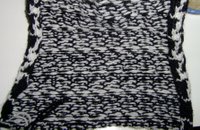
It will certainly be colourful....
 The designer used three different colourways of the Kureyon to vary the stripes. I loved it even before I'd even knit a single stitch with a Noro yarn. It's a clever design, in that the integral sleeves ensure that the striping isn't too insane or clashing.
The designer used three different colourways of the Kureyon to vary the stripes. I loved it even before I'd even knit a single stitch with a Noro yarn. It's a clever design, in that the integral sleeves ensure that the striping isn't too insane or clashing.
 Yay! Kitten hat!
Yay! Kitten hat! I've been fighting on and off for over a year with a stranded 2 colour felted bag project. It's a black and white houndstooth design, and the original intention was to create a roll-shaped bag. The idea comes from a book of Paton's felted bag patterns published last fall.... the houndstooth design comes from one pattern, and the shape comes from another.
I've been fighting on and off for over a year with a stranded 2 colour felted bag project. It's a black and white houndstooth design, and the original intention was to create a roll-shaped bag. The idea comes from a book of Paton's felted bag patterns published last fall.... the houndstooth design comes from one pattern, and the shape comes from another.
The roll bag pattern calls for a large rectangle to be knit and felted, and then cut into pieces for sewing up. I might just seam up the sides and felt it as a big open bucket bag. We'll see.
I tend to work on it in spurts. It took about three months to get the first couple of inches done, until I got my hands on a copy of Debbie New's Unexpected Knitting with her helpful diagrams for two handed stranding. I picked up speed, and made some great progress early in the year. I abandoned it over the summer, and I picked it up again last night for the first time in months.
Thanks to Debbie New and Brandon Mably, I'm feeling more confident than I used to about stranded knitting, but I'm still no Fair Isle wunderkind. Before I felt the thing, I intend to pour myself a stiff drink and measure my tension. I'm interested to see how far off I actually am....

Weaving as I go, merrily, merrily. (Dear god. Showing off the back of my knitting in public. Grannie would be shocked.)
Knitting for home
A felted bag idea for Lorena, trimmed in a novelty yarn. Stay tuned for pictures! The question is do I apply the novelty yarn trim before or after felting? I think the result will be more predictable if I do it afterwards.
Streetcar knitting
A cashmere hat from a Handmaiden kit because it was 3 degrees this morning.
 That vintage poncho thingy. It sat for a while but it's underway again. This is the back. It's basically two rectangles attached at the shoulders with a hood, and buttons on the side near the waist. It's really just a showcase for this rather lovely variegated wool from Fleece Artist. Sadly, it was in the "delete bin" of a nearby yarn store, and doesn't seem to be in production any more.
That vintage poncho thingy. It sat for a while but it's underway again. This is the back. It's basically two rectangles attached at the shoulders with a hood, and buttons on the side near the waist. It's really just a showcase for this rather lovely variegated wool from Fleece Artist. Sadly, it was in the "delete bin" of a nearby yarn store, and doesn't seem to be in production any more.I'm off on a roadtrip this weekend with a couple of my girl pals and am looking forward to some serious knitting in the car. I hope to finish the hat and get some good work done on the poncho.
